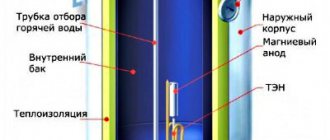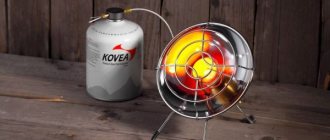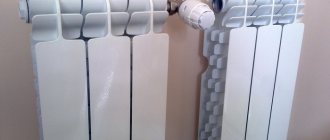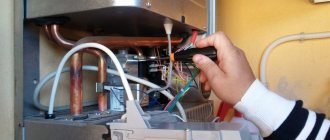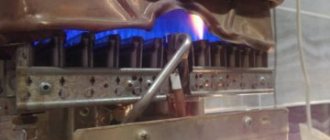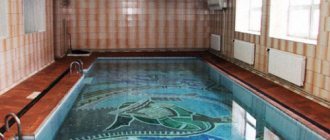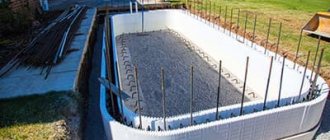Pros and cons of water heaters
The benefits of using gas pool water heaters include the following:
- high efficiency and heating speed;
- ability to work autonomously;
- absence of combustion products;
- simple operation;
- wide selection of models.
Disadvantages of the device:
- the need for a constant gas supply of acceptable pressure;
- constant monitoring of gas leaks;
- strict requirements for the room where the device is installed;
- complexity of connection (services of qualified specialists are required);
- the need for professional service;
- regular monitoring of equipment performance.
Using a special film to preserve heat
A thermal blanket will help heat the water in the pool. The canvas is pulled over the object, and heat will not be reflected from the water, being retained by the film.
This method helps to increase the temperature of the top layer of water by 4-5 °C. For uniform maintenance, you will need to turn on a pump that mixes the liquid. The film is produced according to standard pool sizes or cut to fit a homemade design.
Advantages:
- acceptable price;
- ease of operation (without the participation of specialists);
- protection from falling leaves, insects, and other debris.
The disadvantages include the inability to use film as the main method of heating water.
Design and principle of operation
The gas burns in the heater, releasing heat, which is transferred to the water passing through the circuit of the device.
The heat exchange device does not heat the water directly. This is an optimization element that increases the efficiency of heat exchange between 2 media: water in the pool and coolant operating from a heat source.
Inside the heat exchanger, they are separated by a system of thin tubes or plates made of a material with high thermal conductivity. The larger the area of this contact, the greater the amount of heat that manages to move from a more heated environment to a less heated one.
A high degree of efficiency and cost-effectiveness of equipment is achieved through the use of natural fuel. The power of the gas heater starts from 115 kW. Propane ensures stable maintenance of a comfortable water temperature for a long period of time.
Purpose and types of water heaters for pools
All water heaters, depending on their purpose, are divided into indoor and outdoor. However, this classification is conditional. Some gas, wood and electric systems can also be used to heat water in a backyard pool. In the summer, you can use outdoor devices to increase the temperature in indoor tanks.
Depending on the type of design, water heaters are:
- flow-through;
- heat exchange;
- heat pumps.
Another classification is based on the type of energy used to raise the temperature of the water.
Water heaters are solar.
According to it, the following types of heaters are distinguished:
- gas;
- electrical;
- solar;
- thermal;
- fuel, etc.
How to choose?
Gas heaters have the following technical characteristics:

Maximum operating temperature: shows how hot the gas heater coolant can be.- Thermal power: depends not only on the contact area between the two media, but also on the type of liquid being processed.
- Throughput (measured in cubic meters per hour): this parameter shows the time during which the entire volume of water in the pool will pass through the heat exchanger.
After determining the appropriate parameters for the technical characteristics of the gas heater, the required power of this device should be calculated.
To do this, you need to take into account factors:
- pool volume;
- volume of constant heat loss;
- heat source power;
- coolant temperature;
- desired pool water temperature;
- the time period during which water needs to be heated, provided that it has just been collected.
It is advisable to select the power of the equipment corresponding to the maximum level of heat loss. This is enough to maintain an acceptable water temperature during peak loads on the system.
The rules for saving resources are also observed. The lower power limit is selected with a coefficient of 0.7 from the volume of the pool bowl.
Next, you need to calculate the acceptable power of the heat exchanger. To do this, use the formula P = ((V*C * ΔT)/t1) + q*S, where :
- P – required heat exchanger power (W),
- C – specific heat capacity of water at a temperature of 20°C (W/kg*K);
- ΔТ – difference in temperature of cold and hot water (оС),
- t1 – optimal time for heating the entire pool (hours),
- q – heat loss per hour per square meter of water surface (W/m2),
- V – volume of water in the pool (l).
The obtained result is compared with standards. For example, for an outdoor pool, the acceptable power of a gas heater is 1000 W/m2; if the pool is partially closed (a canopy or part of a building), the power should be 620 W/m2. For indoor pools, the described parameter should correspond to 520 W/m2.
An important parameter is the operating time of the heat exchanger to heat the water in the pool to the required value. The calculation is carried out using the formula t = 1.16 * V * T / P, where :
- t – required time in hours;
- V – volume of water in the pool in cubic meters;
- T – required temperature difference in degrees;
- P – declared power.
For example, the initial temperature of the water in the pool is 20 degrees Celsius. It needs to be heated to 26 degrees. The temperature difference is 6 degrees. The volume of the bowl is 30 cubic meters. A heat exchanger with a capacity of 6 kW is also installed. By calculation we get the value 34.8 hours.
Methods of heating water in a swimming pool. What is more profitable?
All owners of an artificial pond intended for swimming sooner or later face the question of how to heat and maintain comfortable water in the pool. Modern manufacturers offer several basic options:
- Electric boiler;
- Solar collectors;
- A gas boiler;
- Heat pumps.
An electric boiler is the simplest and fastest solution. By the way, this is the first thing that comes to most people’s minds. If you have a small pool with a volume of 1-3 m³, this method may be suitable. But for a larger pool, problems may arise. The biggest problem is lack of power. In most summer cottages, the allocated electrical power is 3-5 kW. If you install an electric boiler, even 3 kW, you will not be able to turn on the electric kettle or iron, as well as the light, refrigerator and many other electrical appliances. If you have a private house on a site for individual housing construction, you will be allocated 3 phases of 15 kW. This is already something. But then let's do the math. Let's assume you need 7 kW of power to maintain the pool. The swimming season is from the beginning of May to the end of September, even 150 days. For those who want to find fault with the power and say that in the summer months the sun will help during the day, reduce the power by 2 kW and calculate the average value for the swimming season - 5 kW.
5*24*150=18000 kW
This is exactly how much electricity you will spend to maintain the temperature in the pool for 5 months. Scary number? For example: in Krasnodar the cost of one kilowatt is about 4.5 rubles. Simple arithmetic: 18,000*4.5=81,000 rubles. For that kind of money, few people will want to heat the water in the pool. Yes and again. But what if you need not 7 kW, but 15 kW or even more. Once again we are faced with capacity overload.
Also, do not forget that such equipment is usually located in the boiler room, and you decided to install a pool at the other end of the yard. Question. How to lay pipelines? Either dig trenches in a landscaped area, or install them on top of the lawn and paving stones, and stumble over them all summer. Then dismantle and store tens of meters of pipe somewhere.
Conclusion. Heating a pool with an electric boiler is not the best choice and is also expensive to operate. Suitable for small children's pools.
A solar collector is the second most popular idea for heating a pool. The key word here is "FREE". But is it really sunny and free, let's find out. In the best case, from 1 square meter of solar collector you will get 3 kW per day. Let's take 15 hours, when the sun is warm in the summer. Therefore, from one square meter we will remove a maximum of 200 watts. With a requirement of 5 kW, this is 25 square meters of solar collectors. And also piping, glycol, organization of the discharge of excess heat, frames for installation and a quarter of a hundred square meters of precious land. Can you imagine how much 25 m² of solar collectors and the rest of the piping cost, including installation? We won't even count. And where is it free? The initial investment will be enormous. It’s funny to look at photos on the Internet with happy faces and two solar panels next to each other.
Conclusion. Solar collectors have the right to life as auxiliary heating of water in the pool only in the summer in sunny weather. In cloudy weather and cool days, such a system will not work effectively. The cost of equipment and installation for full heating will amount to hundreds of thousands of rubles.
A gas boiler is a good and inexpensive way to heat and maintain the required temperature of the water in the pool. In addition, during the summer, spring and warm autumn months, this equipment is used only for preparing hot water for domestic needs, i.e. Almost all the power is free. The disadvantages, like the electric boiler, are the laying of lines from the boiler room to the pool. You will also need to install a special titanium heat exchanger and automation so as not to mix the boiler water and water from the pool. The cost of one kilowatt of gas compared to the example of an electric boiler will be 6-7 times less. Accordingly, the cost of maintaining the water temperature in the pool for the season will be within 12,500 rubles. This is already a little.
Conclusion. A gas boiler is a good way to maintain temperature. We can say that those who have gas are lucky.
A heat pump is considered the most successful option for heating water in a home pool. The principle of operation can be seen in this article. This equipment, when operating for heating, when the outlet temperature is 30-32°C and the ambient temperature is +25-27°C, can operate with a conversion in the region of 10-12. This means that with a consumption of only 1 kW, the heat pump will have a power of 12 kW. In our example above, it will consume 700 watts and output, like an electric boiler, 7 kW. Accordingly, payments will decrease significantly. You can read more about this heating method in the article: “Heating a pool with a heat pump”
The biggest disadvantage of such equipment is its lack of popularity in our country and the initial investment. The cost of a 9 kW heat pump ranges from 90,000-120,000 rubles. But operating costs are lower even than a gas boiler. And the payback, in comparison with an electric boiler, does not exceed one season. Comparison table in this article. Current prices
This equipment is installed next to the pool, does not require laying long pipes, can be easily disconnected and transported along with the pool to another location on the site. Household models are powered from a regular outlet. They are easy to install and operate. In recent years, most heat pump models have been produced in inverter versions. This provides additional savings and minimizes the load on the power grid.
Conclusion. Heat pumps are the best option for heating a pool at home. Most importantly, they will ensure round-the-clock maintenance of the set temperature in the pool and then relaxation is ensured on any day, 24 hours a day.
| Comparison parameter | Heat pump 10 kW | Electric boiler 10 kW | Note |
| Consumption | 0,19-1,43 | 10 kW | The consumption of a heat pump is several times less than that of an electric boiler with equal output power. |
| Number of phases | 1 | 3 | Not all areas have free 10 kW and 3 phases. With an electric boiler, the load on the home electrical network increases. The wire cross-section increases. The heat pump will consume a maximum of 1.5 kW. He can even work in gardening partnerships. |
| Jumps when turned on | no (soft start) | yes (stepwise) | The heat pump starts and stops smoothly. No power surges. Electric boiler stages can put a strain on the network. |
| Network load | minimum | takes almost everything | The heat pump can be connected to a regular outlet or extension cord, but the electric boiler can only be connected to the electrical panel. It will cost much more. |
| Installation | simple (do it yourself) | specialist required | Installation of a heat pump is simple and can be done independently. To install an electric boiler, specialized installers will be required. |
| Location | next to the pool | in a special room | The heat pump can be installed anywhere and moved along with the pool; the electric boiler will have to be installed in a special room. |
| The need to lay pipes in the ground to the pool | minimally | gasket required | The laying of pipes for a heat pump is minimal; for an electric boiler, it may be necessary to disturb and then improve the area. |
| Price | 136000 | 35000 | The initial investment is higher for a heat pump. |
| Additional materials | 6000 rub. | 15,000 rub. | More money is spent on piping the electric boiler. |
| Additional heat exchanger | No | 22000 rub. | If the water contains chemicals, an intermediate heat exchanger is installed. |
| Operating period | May-September (150 days) | May-September (150 days) | We believe that with heating the operating period increases to five months, and in the southern regions even more. |
| Maintenance consumption for the entire period | 3240 kW | 36000 kW | We assume that the average consumption during the period of using the pool will be 7 kW/h. |
| Price per 1 kW in Krasnodar | 5.5 rub. | 5.5 rub. | The average price for the Krasnodar region was accepted. |
| Maintenance cost per season | 17820 rub. | 198,000 rub. | The total amount that will have to be spent on maintaining comfortable water in the pool over the season. |
| Difference in costs per season for heating a pool | 0 | 180180 rub. | The costs of maintaining the temperature of the pool water with a heat pump will be several times less. |
| Cost of equipment and expenses per season | 160,000 rub. | 270,000 rub. | The total costs in the first year of operation will be in favor of the heat pump. Further there will be only benefits. |
| Heat pump payback (days) | 119 days | will cost more | For this comparison, the payback of a heat pump compared to the initial cost of an electric boiler will be a maximum of one season. |
Budget heating options
It is impossible not to mention the budget methods of heating home pools, which are still used by their owners. These include:
- “Snail” is the name given to a mini-solar collector that does not require installation and is easy to use. But it will not provide enough heat to maintain and is tied to the presence of sunny days
- Thermal blanket stretched over the bowl. Using this method, in a few hours you can heat the water by 3–4 degrees, depending on the size of the pool. Additionally, the thermal blanket protects the inside of the home pond from insects, dust and fallen leaves.
- Wood heaters. For heating you will need a solid fuel boiler and a certain amount of firewood. You will also need to constantly monitor their combustion. You cannot place such equipment near the pool; the smoke can smoke all the things nearby.
Even a small pool for a summer house or suburban area needs heating. It will make not only swimming comfortable, but also getting out of the water, allowing you to swim in your home pond early in the morning, late in the evening, and on a cloudy day.
Boiler models for heating water with gas, prices
Popular models of gas heaters for swimming pools are the following:
Vanward Tankless
Affordable gas pool heater made in China. Suitable for small medium bowls for home use . Compliance with ISO9001 standards certifies the high quality and safety of the product.
The compact size of the device allows it to be installed in limited spaces. The average cost of such a heater is from 15,000 to 16,000 rubles.
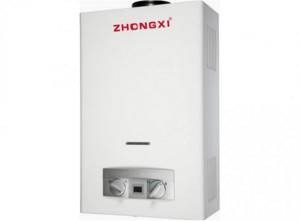
Volcano
Gas heaters of the Vulcan brand are compact, easy to use and efficient . Suitable for stationary, quickly installed and swimming pools.
The supply type of heater requires its connection to a water filtration system, the productivity of which should be in the range from 2 to 9 thousand liters per hour. The cost of the model is 30-35 thousand rubles.

Davey
Davey gas heaters are suitable for large-volume amateur and professional pools. They are used in SPA centers, swimming establishments and private residential properties (country houses, cottages, dachas).
HSI (hot surface ignition) technology has been introduced, which reduces fuel consumption by reducing pilot light consumption. The average cost of the model is about 220-250 thousand rubles.
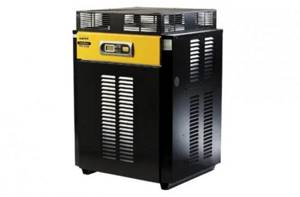
Pool Heaters vs. Heat Pumps: So Which Should You Choose?
Buying a pool heater requires some thought. Both heat pumps and water heaters are great options, and neither is inherently better than the other. When making a decision, try asking yourself the following questions:
- How important is fast heating on demand? Both water heaters and heat pumps can heat a pool to your desired temperature, but water heaters typically run a little faster.
- What season do you use the pool? If you use your pool all year round, including in winter, a gas or propane water heater may be your best choice. If you use the pool only during warm periods, a heat pump is better.
- How much does natural gas cost compared to propane in your area? If you decide to use a gas heater, you'll want to be sure to take a close look at the relative costs and availability of gas and propane in your area.
- What's more important: saving up front or saving in the long term? Overall, because a heat pump transfers heat rather than creating it, it uses significantly less energy in the long run. However, this may cost more.
If you are unsure which heating method is best for you, talk to a professional. A swimming pool installation expert will talk to you about the climate factors, efficiency issues and lifestyle needs that will influence your decision.
How to connect to the tank?
Installation and configuration of such equipment for the pool requires highly qualified specialists. Connection is carried out in accordance with the attached instructions. In general, the connection algorithm consists of the following steps:
- Installing the heater on a flat surface near the pool.
- Connecting the hose from the filter system to the lower pipe of the heater.
- Turning on the filter system and releasing air from it.
- Connecting the reducer to the gas cylinder.
How to use?
To start heating, it is enough to provide gas supply to the device and turn on the equipment with the appropriate switch. Next, after the operating time of the heat exchanger, previously calculated by the appropriate formula, you need to check the temperature in the pool.
It should correspond to the expected value: swimming pools, sports pools - from 24 to 26 degrees Celsius, children's pools - from 28 to 30 degrees Celsius, pools for hydromassage and similar water treatments - from 32 to 38 degrees Celsius.
Other methods of heating an artificial reservoir
Let's look at what devices can be used to heat the water in the pool.
Geyser
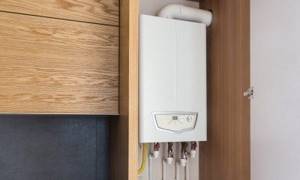
However, it must be taken into account that this method is only suitable for small-volume remote pools. They are installed on a temporary basis at dachas or on the territory of a country house.
The power of the column must be at least 20 kW. You can easily purchase such a product in any specialized store at a cost of 3 to 6 thousand rubles.
Gas cylinder
Gas can be supplied from a gas cylinder . To connect equipment to such a cylinder, you should first of all pay attention to the thread of the nut (in many heater models the nut has a left-hand thread) that secures the heater connection point. You need to screw it counterclockwise as tightly and carefully as possible.
Next, open the cylinder valve. To do this, you need to rotate it counterclockwise. At this time, you should finally make sure that there is no gas leakage from under the nut.
To make sure that gas does not flow into the burners, you need to unscrew the fuel supply control screw located on the reducer. This is also done counterclockwise until the value on the pressure gauge reaches 0 MPa. Next you need to light the burner.
Before starting you should check:
- is the water circulation turned on?
- are there any leaks;
- is a reducer connected to the cylinder;
- Is the valve open?
Ignition is carried out with a special gas lighter. This is the easiest and safest way to properly light a burner.
When turned on, it is brought to the burner and at the same time the gas supply screw is rotated clockwise. After ignition, you need to set the value to 0.1 MPa on the pressure gauge for stable operation.
Principle of operation
The heat exchanger itself does not heat the water. It is only an optimized device for effective heat exchange between two media. One of them is the coolant from the direct heat source, and the second is just water from the pool.
In a heat exchanger, the two media are separated only by thin walls of pipes or plates with high thermal conductivity. The higher the area of such contact, the more heat will have time to transfer from the hotter liquid to the colder one.
In essence, the heat exchanger is always in-line, although the volume of chambers and sections for pumping two media may differ significantly. Tubular and plate heat exchangers are used for swimming pools. The advantage is on the side of tubular devices, since they reduce the resistance to water flow introduced by the device and are less demanding on the purity of the pumped liquid.
The housing forms the first chamber for the heated liquid. This is an oblong cylinder made of a large diameter pipe, closed at both ends with plugs that have fittings for connecting pipes. It is insulated on top to eliminate unnecessary heat loss.
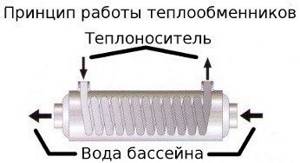
Tubes are distributed inside the housing, isolated from the internal space of the device, with fittings located on the outside. The tube can be one curved in a spiral to increase the contact area and stretching from one edge of the heat exchanger to the other. But it is more efficient to use many tubes in parallel, which are connected at the ends by a manifold. This significantly reduces the hydraulic resistance of the heat exchanger to the coolant circuit and increases the contact area and boundaries between the two liquids.
Main characteristics of the heat exchanger:
- Maximum operating temperature. The maximum heating of the coolant that the device can withstand.
- Thermal power. It depends not only on the contact area, but also on the type of liquid in both circuits and the temperature difference.
- Throughput, measured in cubic meters per hour, determines how long it takes the entire volume of the pool to pass through the heat exchanger.
